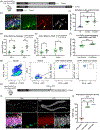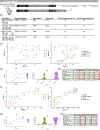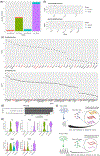Neuronal activity-related transcription is blunted in immature compared to mature dentate granule cells
- PMID: 36811254
- PMCID: PMC10985790
- DOI: 10.1002/hipo.23515
Neuronal activity-related transcription is blunted in immature compared to mature dentate granule cells
Abstract
Immature dentate granule cells (DGCs) generated in the hippocampus during adulthood are believed to play a unique role in dentate gyrus (DG) function. Although immature DGCs have hyperexcitable membrane properties in vitro, the consequences of this hyperexcitability in vivo remain unclear. In particular, the relationship between experiences that activate the DG, such as exploration of a novel environment (NE), and downstream molecular processes that modify DG circuitry in response to cellular activation is unknown in this cell population. We first performed quantification of immediate early gene (IEG) proteins in immature (5-week-old) and mature (13-week-old) DGCs from mice exposed to a NE. Paradoxically, we observed lower IEG protein expression in hyperexcitable immature DGCs. We then isolated nuclei from active and inactive immature DGCs and performed single-nuclei RNA-Sequencing. Compared to mature nuclei collected from the same animal, immature DGC nuclei showed less activity-induced transcriptional change, even though they were classified as active based on expression of ARC protein. These results demonstrate that the coupling of spatial exploration, cellular activation, and transcriptional change differs between immature and mature DGCs, with blunted activity-induced changes in immature cells.
Keywords: Arc; Smart-Seq2; adult neurogenesis; dentate gyrus; hippocampus; immediate early gene; single-nuclei RNA-seq.
© 2023 Wiley Periodicals LLC.
Conflict of interest statement
CONFLICT OF INTEREST STATEMENT
The authors declare no conflict of interest.
Figures



References
Publication types
MeSH terms
Grants and funding
LinkOut - more resources
Full Text Sources
Molecular Biology Databases

